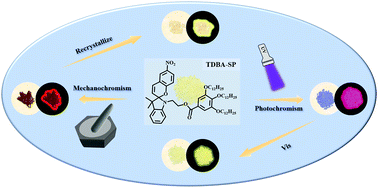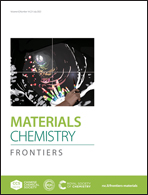Dual-stimuli response of spiropyran derivative modified by long-chains: high-contrast photochromism and mechanochromism†
Abstract
In the solid state, due to insufficient conformational freedom in the process of isomerization, spiropyrans exhibiting reversible photochromism and mechanochromism are quite rare. Herein, a spiropyran derivative (TDBA-SP), which combines high-contrast solid-state photochromism and reversible mechanochromism, is reported. Due to the isomerization of spiropyran, the molecule was susceptible to ultraviolet (UV) light irradiation and exhibited high-contrast emissions (from light yellow to red). What is more, the lower melting point is conducive to the further application of TDBA-SP by heating and fully mixing with a polymer matrix without any solvents. In this work, soft and uniform films composed of TDBA-SP and polydimethylsiloxane (PDMS) were obtained and these films can realize at least 50 photo-switching cycles by UV irradiation and heating treatment. Meanwhile, this molecule was sensitive to stimulation by force. After grinding for 10 minutes, the initial yellowish powder obviously turned brown, accompanied by red fluorescence emission. Further, the mechanochromic process can be greatly recovered by recrystallizing in a mixed solution of dichloromethane (DCM) and n-hexane. In particular, taking advantage of mechanofluorochromism, handwriting will become another form of anti-counterfeiting protection. The reversible dual-response properties of this molecule make it possible to provide excellent anti-counterfeiting guarantees.



 Please wait while we load your content...
Please wait while we load your content...